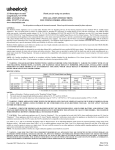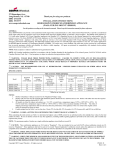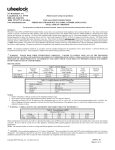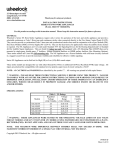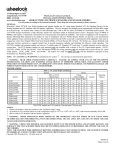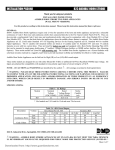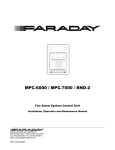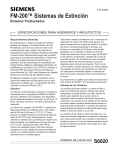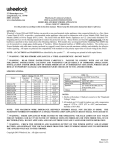Download Siemens HS Specifications
Transcript
INSTALLATION INSTRUCTIONS MULTI-CANDELA FOUR WIRE HORN STROBE APPLIANCES (WALL MOUNT VERSION) IMPORTANT – All audible and visual signaling appliances must be installed in accordance with all applicable national and local fire alarm codes and any other required regulatory agencies. Series HS-MC Multi-Candela Horn Strobe provides four selectable candela settings (15, 30, 75, 110). The HS-MC allows for independent operation of the strobe circuit and the horn circuit. It is the ideal choice for retrofit applications as well as new installations. The HS-MC appliance is UL Listed under Standard 1971 for Signaling Appliances for the Hearing Impaired and UL Standard 464 for Audible Signal Appliances. The HS-MC is also ULC Listed under Standard CAN/ULCS526-02 for Visual Signaling Appliances and Standard CAN/ULCS525-99 for Audible Signaling Appliances for Fire Alarm Systems. It is listed for indoor use only and can be mounted to double-gang, 4” backbox, 100mm European backbox or MT-SUR-BOX surface backbox (See wiring and mounting information). This appliance is listed for wall mounting only. The HS-MC appliance uses a xenon flashtube with solid state circuitry enclosed in a polycarbonate lens to provide maximum visibility and reliability for effective visible signaling. Siemens Series HS appliances provide a selectable continuous or Code 3 horn tone and non-synchronized strobe when connected directly to a Fire Alarm Control Panel (FACP). They can also provide a synchronized Code 3 (or March Time) horn tone and synchronized strobe when connected to a notification appliance circuit running the Siemens sync protocol. HS appliances can be field set for High (HI), medium (MED) dBA or low (LO) dBA sound output. . NOTE: The Code 3 temporal pattern (1/2 second on, 1/2 second off, 1/2 second on, 1/2 second off, 1/2 second on, 1-1/2 off and repeat) is specified by ANSI and NFPA 72 for standard emergency evacuation signaling. The Code 3 Horn should be used only for fire evacuation signaling and not for any other purpose. The HS-MC is designed for use with either filtered DC or unfiltered fullwave-rectified (FWR) input voltage. All inputs are polarized for compatibility with standard reverse polarity supervision of circuit wiring by an FACP. NOTE: All Canadian Installations should be in accordance with the Canadian Standard for the Installation of Fire Alarm Systems – CAN/ULC-S524-01 and Canadian Electrical Code, Part 1. Final acceptance is subject to authorities having jurisdiction (AHJ). NFPA 72/ANSI 117.1 conform to ADAAG Equivalent Facilitation Guidelines in using fewer, higher intensity strobes within the same protected area. NOTE: Refer to P/N 315-096363 for the maximum number of appliances on a single notification appliance circuit. SPECIFICATIONS: Model* HS-MC Description Continuous Horn Code 3 Horn or March Time** Table 1: UL/ULC Listed Models and Ratings Operating Voltage (Special Application) Voltage Range Per Per UL 1971 CAN/ULC-S526-02 (VDC/VRMS) (VDC/VRMS) 16.0-33.0 20.0-31.0 *Available in red and white. Volume Low Medium High Low Medium High Strobe Candela (cd) 15/30/75/110 Table 2: dBA Sound Output for 24VDC Models Reverberant Per UL 464 Anechoic dBA @ 10 Ft. Per CAN/ULC-S525-99 16.0VDC 24VDC 33.0VDC 20.0VDC 24VDC 31.0VDC 80 83 86 88 90 91 85 88 91 93 95 97 88 91 93 97 99 100 75 79 82 88 90 91 80 84 86 93 95 97 84 87 89 97 99 100 **Available in sync mode only. Siemens Building Technologies, Inc. 8 Fernwood Road Florham Park, New Jersey 07932 P84391-003B Sheet 1 of 4 Figure 1: ULC Directional Characteristics 95dB -6dB -3dB -3dB 30° 85dB 27° -3dB 3. This model is UL/ULC Listed for indoor use with a temperature range of +32°F to +120°F (0°C to +49°C) and maximum humidity of 93% ± 2% RH. The effect of shipping and storage temperatures shall not adversely affect the performance of the appliance when it is stored in the original cartons and not subjected to misuse or abuse. -6dB -6dB 60° 20° 30° 48° 83dB 95dB 81dB 80° -3dB -6dB NOTES: 1. The strobe will produce 1 flash per second over the Input Voltage range. 2. This horn/strobe model meets the required light distribution patterns defined in UL 1971 and ULC-S526-02. When calculating the total current: Use Tables 3 & 3A to determine the highest value of “RMS Current” for an individual HS-MC then multiply the value by the total number of HS-MC Appliances. Be sure to add the currents for any other appliances powered by the same source and to include any required safety factors. Note: These notification appliances are UL Listed as “Special Application”. They are intended to be used only with Siemens notification appliance circuits. CANDELA SETTING WILL DETERMINE THE CURRENT DRAW OF THE PRODUCT. DC FWR DC FWR Table 3: Current Ratings (Horn Only) Maximum RMS Current (Amps) Input Voltage Lo Med 16-33VDC 0.027 0.068 16-33VRMS 0.041 0.050 Table 3A: Current Ratings (Strobe Only) Maximum RMS Current (Amps) Input Voltage 15cd 30cd 75cd 16-33VDC 0.064 0.098 0.175 16-33VRMS 0.108 0.164 0.268 Hi 0.110 0.094 110cd 0.233 0.368 THESE APPLIANCES WERE TESTED TO THE VOLTAGE LIMITS OF 16.0-33.0 VOLTS FOR 24V MODELS USING FILTERED DC OR UNFILTERED FULL-WAVE-RECTIFIED VOLTAGE. DO NOT APPLY VOLTAGE OUTSIDE OF THIS RANGE. Note: Refer to the installation instructions for the appropriate NAC to find the maximum allowed voltage drop. Use this value along with the current draw for the appliance to determine the allowable wire resistance. The maximum wire resistance between strobes shall not exceed 35 ohms. CAUTION: The strobe is not designed to be used on coded systems in which the applied voltage is cycled on and off. NOTE: The horn circuit is compatible with coded systems only if the unit is wired for independent horn and strobe operation per figure 4. WARNING: MAKE SURE THAT THE TOTAL RMS CURRENT REQUIRED BY ALL APPLIANCES THAT ARE CONNECTED TO THE SYSTEM’S PRIMARY AND SECONDARY POWER SOURCES DO NOT EXCEED THE POWER SOURCES’ RATED CAPACITY OR THE CURRENT RATINGS OF ANY FUSES ON THE CIRCUITS TO WHICH THESE APPLIANCES ARE WIRED. OVERLOADING POWER SOURCES OR EXCEEDING FUSE RATINGS COULD RESULT IN LOSS OF POWER AND FAILURE TO ALERT OCCUPANTS DURING AN EMERGENCY, WHICH COULD RESULT IN PROPERTY DAMAGE AND SERIOUS INJURY OR DEATH TO YOU AND/OR OTHERS. Siemens Building Technologies, Inc. 8 Fernwood Road Florham Park, New Jersey 07932 P84391-003B Sheet 2 of 4 SOUND OUTPUT (SPL) AND CANDELA SETTINGS: Figure 2: Showing Location of Candela Selector and Jumper Plugs CANDELA SELECTOR TOP C1 P83511 ( ) AH 15 75 R5 J2 B R J2 H M L J3 + STR - T B 1 J1 H M L C O D E 3 + AUD - J1 30 110 CANDELA POINTER C O D E 3 Factory setting is on 15 candela, Medium dB and Code 3. WARNING: THE CANDELA SELECT SWITCH MUST BE FIELD SET TO THE REQUIRED CANDELA INTENSITY BEFORE INSTALLATION. WHEN CHANGING THE SETTING OF THE CANDELA SELECT SWITCH, MAKE CERTAIN THAT IT “CLICKS” IN PLACE. AFTER CHANGING THE CANDELA SETTING, THE APPLIANCE MUST BE RETESTED TO VERIFY PROPER OPERATION. Figure 3: Jumper Plug Settings for High, Medium, Low dB, Code 3 Horn (or March Time) and Continuous Horn Setting. J2 J2 H M L H M L HIGH HORN SETTING • J2 C O D E 3 H M L MEDIUM HORN SETTING • LOW HORN SETTING J1 C O D E 3 CODE 3 HORN SETTING J1 CONTINUOUS * HORN SETTING • Use needle nose pliers to pull and properly insert the jumper plug. No jumper plug is needed for continuous horn setting. However, it is recommended that the jumper plug be retained in the unit for future use (if needed) as shown in Figure 3. The HS-MC must be set for Code 3 (or March Time) horn when used with the sync module. If the HS-MC audible is connected to a coded system, the continuous horn setting must be used. WIRING AND MOUNTING INFORMATION: Figure 4: Audible signal and strobe operate independently. TB1 + STR - FROM FIRE ALARM CONTROL PANEL (FACP) OR + PRECEDING APPLIANCE - + AUD - FROM FACP OR + PRECEDING APPLIANCE TO NEXT APPLIANCE + OR END OF LINE RESISTOR (EOLR). Figure 4A: Audible and strobe operate in unison. Shunt wires are supplied. + STR FROM FACP OR + PRECEDING APPLIANCE - TB1 + AUD - TO NEXT APPLIANCE + OR EOLR - TO NEXT APPLIANCE + OR EOLR. RED SHUNT WIRE BLACK SHUNT WIRE Figure 5: • • HS-MC Appliances have in-out wiring terminals that accepts two #12 to #18 American Wire Gauge (AWG) wires at each screw terminal. Strip leads 3/8” inches for connection to screw terminals. Break all in-out wire runs on supervised circuit supervision as shown in Figure 5. The polarity shown in the wiring diagrams is for the operation of the appliances. The polarity is reversed by the FACP during supervision. The following figures (A-D) show the maximum number of field wires (conductors) that can enter the backbox used with each mounting option. If these limits are exceeded, there may be insufficient space in the backbox to accommodate the field wires and stresses from the wires could damage the product. Check that the installed product will have sufficient clearance and wiring room prior to installing backboxes and conduit, especially if sheathed multiconductor cable or 3/4" conduit fittings are used. Siemens Building Technologies, Inc. P84391-003B Sheet 3 of 4 Figure A MOUNTING PROCEDURES: Figure B FLUSH (4" BOX) FLUSH (2-GANG BOX) 4" SQ. X 2-1/8" DEEP BACKBOX 1. 2-GANG x 3-1/2" DEEP BACKBOX 2. #8-32 SCREWS #6-32 SCREWS SCREW COVERS SCREW COVERS MAXIMUM NUMBER OF CONDUCTORS AWG #18 AWG #16 AWG #14 AWG #12 8 8 8 4 MAXIMUM NUMBER OF CONDUCTORS AWG #18 AWG #16 AWG #14 AWG #12 8 8 8 3. 8 4. Figure C Figure D CONCEALED CONDUIT MOUNTING EXISTING BOX IN WALL BACKBOX (MT-SUR-BOX) SURFACE MOUNTING BACKBOX (MT-SUR-BOX) 5. 6. WOOD SCREWS 7. #8-18 SCREWS #8-18 SCREWS SCREW COVERS This HS-MC model can be flush mounted to a 100mm backbox (Figure A) or double-gang backbox (Figure B). It can also be surface mounted to a indoor/outdoor backbox (Figures C & D). Mounting hardware for each mounting option is supplied. Conduit entrances to the backbox should be selected to provide sufficient wiring clearance for the installed product. Do not pass additional wires (used for other than the signaling appliance) through the backbox. Such additional wires could result in insufficient wiring space for the signaling appliance. When terminating field wires, do not use more lead length than required. Excess lead length could result in insufficient wiring space for the appliance. Use care and proper techniques to position the field wires in the backbox so that they use minimum space and produce minimum stress on the product. This is especially important for stiff, heavy gauge wires and wires with thick insulation or sheathing. Connect field wires to the HS-MC terminal block (polarity must be observed). Bend the field wires up 90° at the connection to the terminal block. Carefully push the field wires into the backbox by hand. Press the HS-MC to the backbox, verifying that it is seated and aligned correctly. Fasten the HS-MC to the backbox using the supplied screws. SCREW COVERS MAXIMUM NUMBER OF CONDUCTORS AWG #18 AWG #16 AWG #14 AWG #12 8 8 8 8 MAXIMUM NUMBER OF CONDUCTORS AWG #18 AWG #16 AWG #14 AWG #12 8 8 8 8 The HS-MC 110cd setting is Listed for use in sleeping or non-sleeping areas when installed in accordance with appropriate NFPA Standards and the AHJ. WARNING: A SMALL POSSIBILITY EXISTS THAT THE USE OF MULTIPLE STROBES WITHIN A PERSON'S FIELD OF VIEW, UNDER CERTAIN CIRCUMSTANCES, MIGHT INDUCE A PHOTO-SENSITIVE RESPONSE IN PERSONS WITH EPILEPSY. STROBE REFLECTIONS IN A GLASS OR MIRRORED SURFACE MIGHT ALSO INDUCE SUCH A RESPONSE. TO MINIMIZE THIS POSSIBLE HAZARD, SIEMENS STRONGLY RECOMMENDS THAT THE STROBES INSTALLED SHOULD NOT PRESENT A COMPOSITE FLASH RATE IN THE FIELD OF VIEW WHICH EXCEEDS FIVE Hz AT THE OPERATING VOLTAGE OF THE STROBES. SIEMENS ALSO STRONGLY RECOMMENDS THAT THE INTENSITY AND COMPOSITE FLASH RATE OF INSTALLED STROBES COMPLY WITH LEVELS ESTABLISHED BY APPLICABLE LAWS, STANDARDS, REGULATIONS, CODES AND GUIDELINES. NOTE: This equipment has been tested and found to comply with the limits for a Class B digital appliance, pursuant to Part 15 of the FCC Rules. These limits are designed to provide reasonable protection against harmful interference in residential installation. This equipment generates, uses and can radiate radio frequency energy and, if not installed and used in accordance with the instructions, may cause harmful interference to radio communications. However, there is no guarantee that interference will not occur in a particular installation. If this equipment does cause harmful interference to radio or television reception, which can be determined by turning the equipment off and on, the user is encouraged to try to correct the interference by one or more of the following measures: 1) Reorient or relocate the receiving antenna, 2) Increase the separation between the equipment and receiver, 3) Connect the equipment into an outlet on a circuit different from that to which the receiver is connected, and 4) Consult the dealer or an experienced radio/TV technician for help. Siemens Building Technologies, Inc. P84391-003B Sheet 4 of 4




